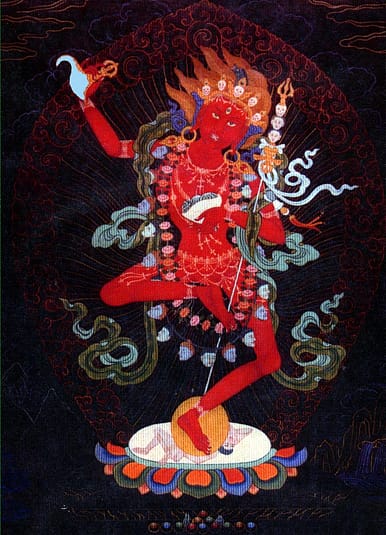
A dakini is a class of being identified in the Indo-Tibetan Buddhist tradition. Her nature is ambiguous, ranging from that of an ordinary prostitute to that of a Fully Enlightened Buddha. She may manifest in the form of a human woman but she is essentially a spiritual force – a real but hidden psychic energy in the human Mind. Although in recent decades she has been seconded to a feminist agenda as a liberated woman, this has been criticized* because she is traditionally considered to be a figure of both female and male psyches. In many ways she is similar to the anima in Jungian analytical psychology – although she has a much deeper meaning than Jung’s presentation of the anima as a man’s unconscious contra-sexual aspects. She is always represented as a female, frequently a young woman, usually naked, often beautiful, wild, and sometimes wrathful, but she occasionally appears as an old woman, a crone, a witch like figure.
Considered as a spiritual force, an energy that resides in the Mind she can manifest in many different ways – as a vision, in dreams, and even consciously or unconsciously ‘projected’ onto human women. She may appear spontaneously but her presence can also be evoked through images, especially in the context of devotional spiritual practices. Her energy is passionate, free, all-consuming, and ecstatic. It is easy to see how her presence is reflected in sexual excitement and romantic love but she is not another form of goddesses like Venus or Aphrodite because in her highest essence she is the energy of Transcendental Liberation – the Bliss of complete freedom from the bonds of Samsara, the dualistic realm. She is what happens whenever the limited and dominating sense of self is renounced – ultimately, completely.
The spiritual life is a quest for Liberation from the bondage of an ego dominated consciousness. It can be approached in a rich variety of ways. It can be primarily a quest for wisdom and understanding, or a pursuit of Beauty, or a drive to Universal love and compassion, or a yearning for something Real, and so on. Each of these spiritual motivations is a genuine force for the good and can be provisionally identified with various Buddhas and Bodhisattvas. The Dakini – in particular Vajradakini – is the driving force and goal of Awakening in the form of Freedom and Bliss. It could perhaps be said that Enlightenment approached with wisdom through the mind is Prajnaparamita or Manjughosha, with universal compassion though the heart is Tara or Avalokiteshvara; and with the Bliss of Freedom, a somatic awareness, is Vajrayogini. Vajrayogini is associated with spiritual practices that focus on awareness of the various energies that flow in the body – or at least in a psychic correlation with the physical body.
As I have got older, looking back over my life, I realise that my spiritual quest has been associated with a strong yearning for spiritual freedom and with the bliss of just letting go of all this that and the other. Lying on a grassy bank one afternoon during a period of intense revision for my ‘A’ levels, I just let go – and it was blissful; Setting out on the road to hitch hike across Europe – ecstatic freedom; and of course La Petite Mort of sexual orgasm; and for several decades I have had experiences of freedom in meditation. I’ve decided to draw together memories of these experiences which I would now regard as glimpses of the dakini – times when I’ve touched Vajrayogini, the force that has driven my spiritual life – even if it was only the tip of her toe.
* For example see Judith Simmer-Brown’s Dakini’s Warm Breath, I also heard Janet Gyatso say something about this matter at the conference Buddhism After Patriarchy in Toronto in 1993